Synthesis example
Synthesis condition - 1
MDI / Polyol / 1, 4 - BDL = 2 / 1 / 1
| 1) Solvent of PU solution: DMF |
| 2) Nonvolatile content of PU: 20% |
| 3) Reaction stopping agent when preparing PU solution: Monoalcohol |
| 4) Finish film thickness when PU solution is coated on a film: Approx. 100 μm |
S-S curve of flexible PU
The film properties of Synthesis condition - 1 were measured according to JIS K 7311.
Tensile test of polyurethane
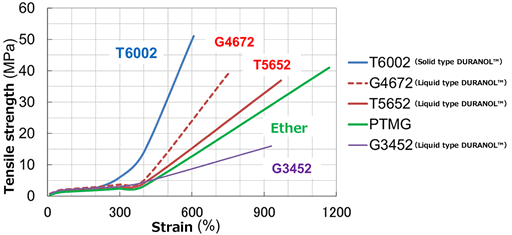

[Measurement condition]
Polyurethane formulation: MDI / Polyol / 1, 4 - BDO = 2 / 1 / 1
Condition: According to JIS K7311
Test piece: 2 mm × 60 mm strip
Measuring instrument: TENSILON tensile testing machine
Hot water decomposition resistance
A film of the synthesis condition - 1 was immersed in hot water at a temperature of 100°C for 14 days and then molecular weight measurement and tensile test were conducted.
- Change in molecular weight
It can be seen that PCD polyurethanes are hard to decompose when compared to polyether urethanes and polyester urethanes.
(Change in the molecular weight of a polyurethane film immersed in hot water at a temperature of 100°C)
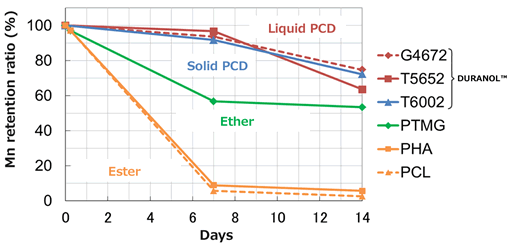

[Polyurethane formulation] MDI/Polyol/1,4-BDO=2/1/1
- Tensile test
A change similar to that of molecular weight can be seen in the tensile elongation. That is, when the polyols are compared, DURANOL™, or homopolymer type polycarbonatediol (PCD), is excellent and the property degradations of PCL and PHA are sharp. PTMG shows degradation between them.
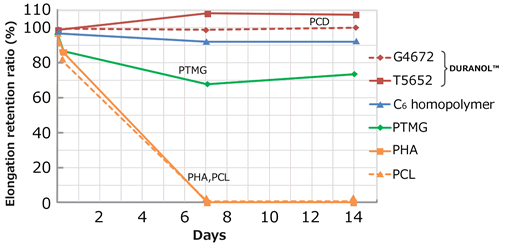

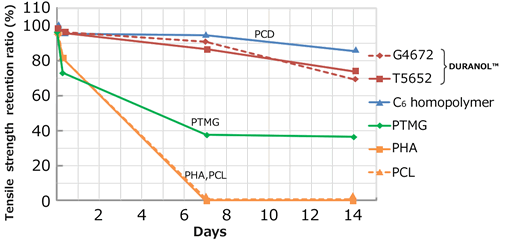

Chemical resistance
A film of the synthesis condition - 1 was immersed in oleic acid or ethanol for 1 week and then degree of swelling (weight change = after – before / before) was measured.
- Oleic acid resistance of various polyols
A polyurethane using polycarbonatediol (PCD) offers higher oleic acid resistance when compared to those using other polyols. Additionally, for the polyurethane using polycarbonatediol (PCD), there is a trend that the more the carbonate bonding amount, the higher the oleic acid resistance.
Change in the property of a polyurethane film immersed in oleic acid (23°C) for 1 week
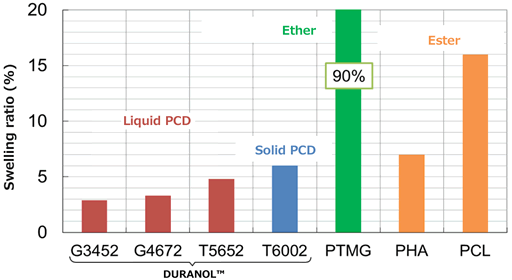

[Polyurethane formulation] MDI/Polyol/1,4-BDO=2/1/1
- Ethanol resistance of various polyols
A polyurethane using polycarbonatediol (PCD) offers higher ethanol resistance when compared to those using other polyols.
Change in the property of a polyurethane film immersed in 50wt% ethanol fluid(23℃) for 1 week
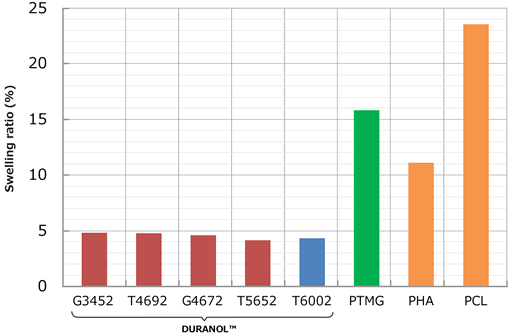

Synthesis condition - 2
H12MDI / Polyol / IPDA = 2 / 1 / 1
| 1) Solvent of PU solution: DMF |
| 2) Nonvolatile content of PU: 30% |
| 3) Reaction stopping agent when preparing PU solution: Alkylamine |
| 4) Finish film thickness when PU solution is coated on a film: Approx. 100 μm |
Heat resistance
A film of the synthesis condition - 2 was stored at 120°C and then the strength retention was measured.
PCD polyurethane shows high retention even after stored at high temperature.
(Change in the property of a polyurethane film stored at 120°C)
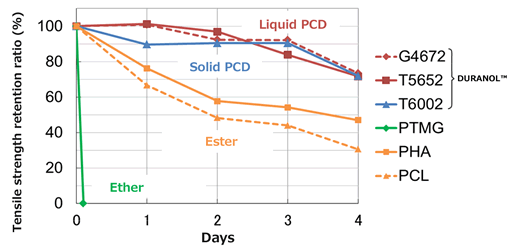

[Polyurethane formulation] H12MDI/Polyol/IPDA=2/1/1













